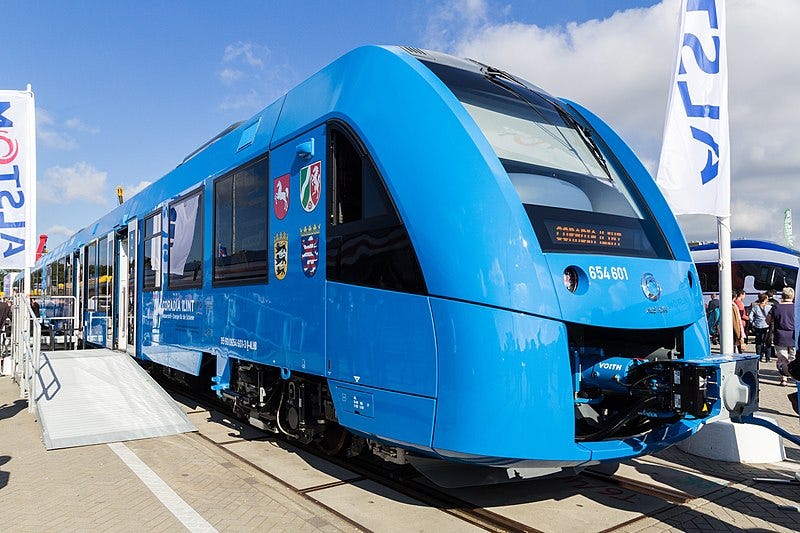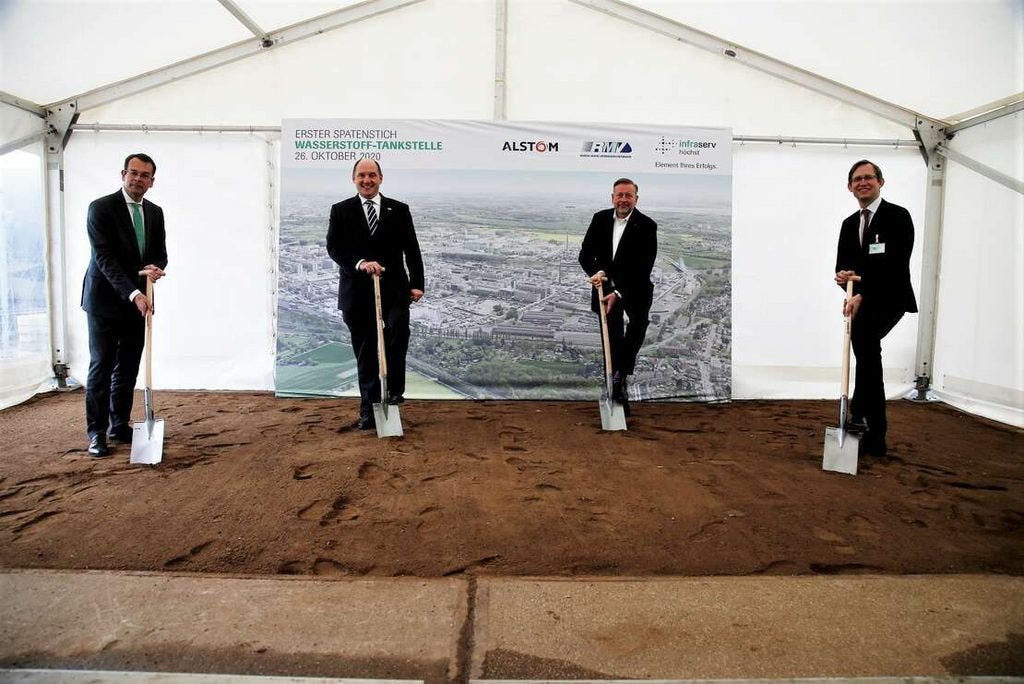If you’re an investor who bought into the hydrogen hype in recent years, you’re in a world of pain right now.
The Global X Hydrogen ETF (HYDR), which tracks hydrogen-related companies, has collapsed 84% from its peak—plummeting from $130 to just $21. Investors who believed in the “hydrogen revolution” have been left holding the bag as reality sets in: hydrogen isn’t the game-changer it was sold as.
Markets have abandoned hydrogen. But in Brussels, failure isn’t a reason to stop—it’s a reason to double down with billions in new subsidies.
Just recently, the EU Commission decided to shovel €3 billion ($3.2B) into hydrogen imports, despite mounting evidence that the technology is neither cost-effective nor scalable.
This isn’t just a financial mistake, it’s a policy disaster with real-world consequences. The failure of a hydrogen train project—once marketed as the world’s largest hydrogen train fleet—is a case study in how the hydrogen hype is burning taxpayer money while failing to deliver actual results.
How to Waste €500 Million in One Easy Step
In 2019, Germany’s Rhein-Main-Verkehrsverbund (RMV), the Frankfurt region’s transport authority, signed a €500 million deal with French manufacturer Alstom. The contract included the purchase of 27 hydrogen trains along with 25 years of maintenance and support. The trains, powered by hydrogen fuel cells instead of diesel engines, were meant to provide a clean, quiet, and efficient alternative to conventional regional rail.
The political messaging was flawless. Officials heralded the deal as proof that Germany was leading the charge into a zero-emission future. The media repeated the claims uncritically. It was a big, bold step toward net-zero transport.
Then reality hit.
The trains barely worked. Passengers suffered through constant breakdowns and service disruptions.
As Frankfurter Allgemeine quotes one pensioner:
“Since December 2022, they’ve brought the entire region to a standstill.” In the winter, passengers were left waiting on the platform for up to two hours.
In a move that shattered the entire premise of the project, RMV had to bring back diesel trains to replace the failing hydrogen fleet. Something that was easier said than done. The market for diesel trains has been virtually wiped out. Hardly anyone produces them anymore, and securing enough replacements took about two years.
In the meantime, many commuters had no choice but to drive or take taxis. A solution no greener than the diesel trains they were supposed to replace. The hydrogen revolution had collapsed into an expensive failure.
So why was hydrogen chosen in the first place?
The Path of Least Resistance
The Taunus region, where these trains operate, has a logistical challenge: there are no overhead power lines on many of its rail routes. That’s why, for decades, these lines were served by diesel trains—the only practical option for non-electrified tracks.
But as these diesel trains neared the end of their life cycle, public authorities faced a big infrastructure decision:
🔌 Option 1: Build power lines and electrify the routes.
• The technically superior option—proven, efficient, and widely used across Europe.
• But a bureaucratic nightmare. Installing overhead power lines requires years of planning, environmental impact studies, and land-use approvals.
• Local governments would have had to deal with legal disputes and landowner pushback.
💡 Option 2: Take the path of least resistance—hydrogen trains.
• No need to build power lines.
• No need for difficult planning battles.
• Just buy Alstom’s “miraculous” hydrogen trains and skip the hard work.
Alstom wasn’t just selling trains—it was selling a shortcut.
And best of all? The federal government was handing out subsidies. Berlin was so eager to promote hydrogen, it agreed to cover 40% of the additional costs of hydrogen trains compared to diesel. There was free money up for grabs—a gift from taxpayers to make the decision even easier.
And for everyone involved, it was a PR goldmine.
Politicians and CEOs got a chance to pat themselves on the back for embracing innovation and sustainability. No one had to deal with the political headache of real infrastructure planning.
But as commuters became painfully aware, the easy way didn’t work.
A failure of this scale should have been foreseeable—because these hydrogen trains were never properly tested before deployment. Instead of conducting rigorous real-world trials, RMV’s decision-makers ordered 27 hydrogen trains without ever proving they could handle the region’s terrain and operating conditions.
The only test run before the purchase? A single demonstration drive between Wiesbaden and Frankfurt. That route, mostly flat and predictable, was hardly a real test.
But the Taunus region, where these trains were supposed to run, is far more demanding. It’s hilly and requires more power and resilience than a simple commuter line. Yet, no hydrogen train was ever put through extended trials under these real-world conditions before RMV committed to replacing its entire diesel fleet.
Fuel Cells: Always Just 5 Years Away
Even if the testing had been more thorough, the fundamental problems with hydrogen fuel cells would have remained. Similar to fusion and the flying car, hydrogen’s promise is always just around the corner—until you look at the fine print.
Because unlike diesel engines, which are almost indestructible, fuel cells are sensitive to operating conditions. They require a certain temperature range and humidity levels, and must be protected from vibrations and shocks to function efficiently.
And even when they do work, they’re expensive. Maintaining a hydrogen fleet can be twice as expensive as a diesel equivalent, adding another financial burden on top of an already costly technology.
In fact, a study in Baden-Württemberg found that hydrogen trains on the examined routes cost 80% more than line electrification or battery hybrid trains over a 30-year lifespan.
Yet despite these clear drawbacks, hydrogen fuel cells continue to be pitched as the technology of the future. They were invented over 170 years ago, and for decades, companies and governments have insisted that commercial success is just a few years away.
A lot of money has been poured into research, massive subsidies have been handed out, and still, fuel cells remain fragile, expensive, and impractical for most large-scale applications.
Trapped in a Bad Deal
Despite overwhelming evidence that it was a risky bet, Alstom landed a lucrative contract without ever proving its hydrogen trains could actually work. Maybe the company believed it could fix problems on the go, turning the entire project into a taxpayer-funded experiment.
Maybe decision-makers assumed that since hydrogen works in theory, it would work in practice. Either way, RMV locked itself into a half-billion-euro deal before a single train was fully tested in real-world conditions.
Public transit contracts of this size often require significant upfront payments. If that’s the case here, RMV has already burned through much of the budget—before realizing the trains don’t work.
The only thing it refuses to pay for at the moment is ongoing maintenance costs—a small concession, but hardly enough to make up for the scale of the failure. With trains breaking down and diesel making an unwelcome comeback, RMV is already looking for a way out of the contract altogether.
But that won’t be easy. You can bet Alstom’s legal team made sure the contract was watertight. If RMV wants to walk away, it could find itself stuck in a lengthy and costly legal battle. Even if Alstom faces penalties, the structure of such a deal might still give it leverage. Money has already been spent, and getting any of it back will be a fight.
Markets have abandoned hydrogen—only the EU refuses to see reality
The Global X Hydrogen ETF’s 84% crash sends a clear signal: hydrogen isn’t the future. Physics won’t allow it. Even in a perfect scenario, hydrogen wastes about 60% of the original energy before it ever reaches the end user.
As a result, Wall Street, which once embraced the hype, has walked away.
And yet, in Europe, the opposite is happening. Investments in hydrogen projects nearly doubled from $376 million in the first half of 2023 to $712 million in the first half of 2024.
On the surface, that might look like a sign of confidence. But in reality, this isn’t market-driven investment—it’s government-driven subsidies.
The €3 billion German-Dutch hydrogen import scheme mentioned earlier is just one of many state aid schemes. In 2022, the European Commission waved through a record €5.4 billion in hydrogen subsidies. Countless other “smaller” programs in the sub-billion range are nearly impossible to keep track off. That’s not private capital flowing into a promising technology. It’s taxpayer money propping up an industry as investors flee.
This is the core problem: governments don’t operate on market signals, they operate on political narratives. Hydrogen was never going to work—but the EU can’t admit it. Too much money, too many careers, and too much political capital are at stake. So they’ll keep doubling down—until reality forces their hand.
But the real problem goes deeper than money. Brussels is planning to anchor Europe’s energy security on hydrogen. Just a few days ago, the EU Commission’s “Competitiveness Compass for the EU” reaffirmed plans to accelerate investment in hydrogen. Brussels sees it as a key pillar of Europe’s energy future, tying it directly to massive spending on new grid infrastructure.
Europe is gambling its energy future on a technology that can’t even keep a few trains running. Someone will have to pay for this failure. If history is any guide, it won’t be the politicians.
🔥 Know someone who should hear about Europe’s bet on failure? Share this article!










Hydrogen would only work, if you could mandate changes to the laws if physics and chemistry